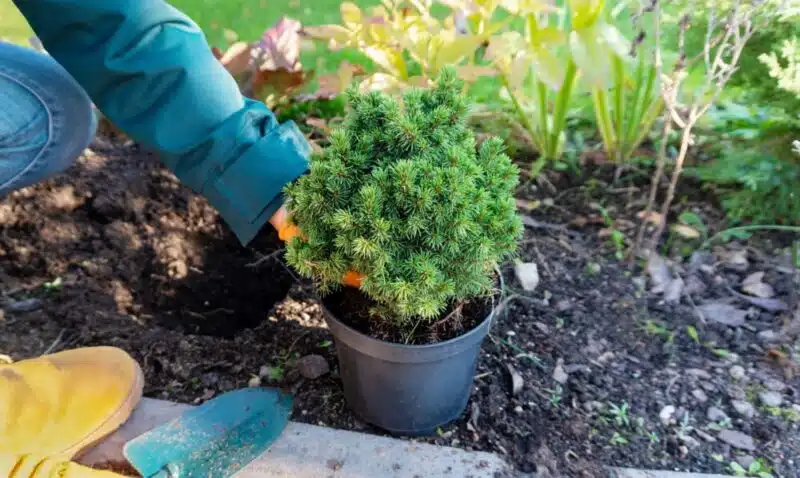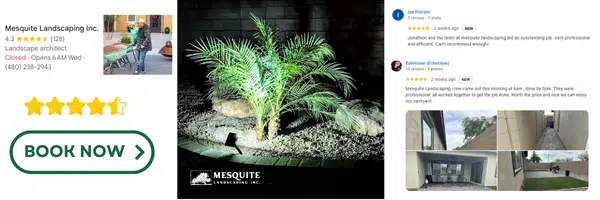Winter Landscaping. Winter lawns are popular with Arizona residents who want to keep a beautiful green landscape year-round. With a little work and a competent, professional partner on your side, you can do just that. Here are some things to think about as you are planning your winter lawns.
Grass Care
While Bermuda is often used in Arizona lawns because it holds up well in the high summer temperatures, it doesn’t perform well in winter lawns. Bermuda goes dormant in the fall, leaving brown patches in place of the greenery. Instead, winter rye grass does much better in the colder seasons, and it thrives when planted mid-October to mid-November. These steps can help you get your winter lawn off to a healthy start.
To prepare your lawn for the winter grasses:
- Stop fertilizing your Bermuda about 30 days before you plan to over seed.
- Two weeks before, reduce the amount of water you are applying by about one-third and raise your mower’s height by 30 to 40 percent.
- Two days before, stop watering entirely and go back to cutting at the original height.
When the over seeding day arrives, lower the mower’s height again by about one-third, now mow, and then leave the clippings as mulch. To adequately cover your lawn, you will need 12 to 15 pounds of rye grass seed per 1,000 square feet. In the first week to 10 days, irrigate the area three times per day. After two weeks, fertilize and start mowing only when the grass is about three inches tall.
Watering in Winter
Taking care of your trees and plants is a little different during the winter. Plants used to desert conditions don’t need too much water and may be damaged by it. Generally, it would be best if you water to a depth of 3 feet for trees, 2 feet for shrubs, 12 inches for grass and ground cover, and 6 inches for winter rye grass. A soil probe or dowel rod can help you measure. Be sure to take into account any significant downpours and adjust your irrigation plan accordingly.
Frost Protection
A drop in nighttime temperatures leads to frost, so as fall approaches, have your sheets and frost cloths ready to cover plants. These tools trap radiant ground heat from the day to warm the plants at night. Remove the sheets during the day so the sun can warm the ground. While it is beneficial with plants, you don’t want to use this method on tree trunks or shrubs. If you have potted plants, you can move them onto a patio or into the garage to protect them from frost.
Pruning Considerations
Cold conditions turn some plants brown, including trees, ground cover, and shrubs. Don’t be tempted to remove the dead parts, though. They form a shield that protects the new growth inside. Instead, only trim the damaged parts once the last frost of the year is gone. Many homeowners choose to put plants sensitive to frost in the backyard, so they are less visible during their brown months.
Fertilizer Planning
Winter fertilization is not a good idea for vines, potted plants, and ground cover because it brings out new growth that can’t withstand the cold nights. Instead, apply mulch to hold moisture and choke out weeds. Save the fertilizer for after the last frost.
Flowers in Your Winter Garden
Arizona’s residents love winter greenery, but many also enjoy beautiful flowers through the colder months. Here are a few lovely blooming options to consider.
- Geraniums look gorgeous, and they perfume your yard with their gentle fragrance. They thrive well in pots and flowerbeds, and they love the sun, which Arizona gets plenty of year-round. In the winter, they need less water than usual and no fertilizer, but you should be sure the roots aren’t drying out. Geraniums are easy to repot in the spring when required.
- Petunias, available in a fantastic array of colors, should be planted with fertilizer. They survive well in the winter but do better if you can keep them out of the wind. These beautiful blooms tolerate wet weather well so that they won’t mind the occasional winter shower.
- Snapdragons are another colorful addition to your garden that is easy to plant. Not only can they survive an Arizona winter. They do better in the cooler temperatures. Here’s a fun fact about snapdragons. Only bumblebees can pollinate them!
Winter Landscaping Services Near Phoenix, AZ
If all of this seems overwhelming, call in the professionals at Mesquite Landscaping. We can help you choose the right plants and features for your home and teach you how to care for them all. Don’t settle for a brown, dried up lawn all winter. Call us today and get started with a free landscape care consultation.
Image Credit: Shutterstock / Nieriss
Cons of Installing Artificial Grass
Now for the part no one likes to talk about—but needs to.
1. Surface Heat
Here's the big one: artificial grass gets hot.
During Arizona summers, turf can heat up to 30–50 degrees hotter than natural grass. That means surfaces can become uncomfortable—or even dangerous—for bare feet and paws.
Solutions include installing shade structures, using cooling infill, or misting systems to lower temperatures.
2. Potential Environmental Concerns
While it conserves water, artificial turf is still made from synthetic materials.
That means at the end of its life, disposal could become an issue if it’s not recyclable. Some brands are working toward greener products, so ask your landscaping company about sustainable options.
3. Limited Biodiversity
Artificial lawns don’t support the same ecosystems as natural ones.
Bees, butterflies, and beneficial insects rely on real plants for survival. If creating a pollinator-friendly environment is important to you, you’ll want to reserve at least part of your yard for real greenery.
4. Repairs and Replacement
Turf is tough—but it’s not indestructible.
Heavy furniture, sharp objects, or poor installation can cause damage. While individual repairs are possible, they can be noticeable and sometimes costly.


